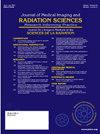Current Alberta radiation therapy care practices for patients with obesity and recommendations for improvement
IF 1.3
Q3 RADIOLOGY, NUCLEAR MEDICINE & MEDICAL IMAGING
Journal of Medical Imaging and Radiation Sciences
Pub Date : 2024-10-19
DOI:10.1016/j.jmir.2024.101768
引用次数: 0
Abstract
Introduction
Obesity has been associated with increased incidence of cancer thereby impacting the number of patients with obesity who may require radiation therapy (RT) treatment. Previous studies have detailed the impacts of obesity on RT treatment delivery including considerations when positioning, imaging, and communicating with patients. However, there is limited literature regarding best clinical practices used by Canadian RT departments when treating patients with obesity. This study aimed to answer the following question: How can the current standards of care (SOC) used by Alberta RT departments be improved to ensure safe and quality care of patients with obesity?
Methods
Semi-structured interviews were conducted with 19 practitioners including three RT managers, two medical physicists, two clinical educators, two radiation oncologists, a senior practice lead, and nine radiation therapists from five cancer centers across Alberta. Interviews were transcribed and analyzed independently by two researchers and used to inform recommendations for improvement to existing care practices.
Results
Four themes emerged as unique considerations for patients with obesity undergoing RT, which included technical factors, interpersonal interactions, patient care factors, and education and training. Recommendations to improve the current SOC in Alberta RT departments included the need for longer appointment times, sufficient staff, accessible mobility equipment, and additional education and training for HCPs tailored towards patients with obesity.
Conclusion
SOC in Alberta could be improved for patients with obesity with modified appointment time, increased staff and resources, and more in depth and tailored education. Implementation of these considerations and recommendations for improvement to the current SOC used by Alberta RT departments has the potential to ensure safe and quality care of patients with obesity.
艾伯塔省目前对肥胖症患者的放射治疗护理方法及改进建议。
导言:肥胖与癌症发病率的增加有关,从而影响到需要接受放射治疗(RT)的肥胖患者人数。以往的研究详细阐述了肥胖对 RT 治疗的影响,包括定位、成像和与患者沟通时的注意事项。然而,有关加拿大放射治疗部门在治疗肥胖症患者时采用的最佳临床实践的文献却很有限。本研究旨在回答以下问题:如何改进艾伯塔省 RT 部门目前使用的护理标准 (SOC),以确保为肥胖症患者提供安全、优质的护理?对 19 名从业人员进行了半结构化访谈,其中包括来自艾伯塔省 5 家癌症中心的 3 名 RT 经理、2 名医学物理学家、2 名临床教育工作者、2 名放射肿瘤学家、1 名高级业务主管和 9 名放射治疗师。访谈内容由两名研究人员独立誊写和分析,并用于提出改进现有医疗实践的建议:结果:肥胖症患者在接受 RT 治疗时有四个独特的注意事项,包括技术因素、人际互动、患者护理因素以及教育和培训。改善艾伯塔省 RT 部门当前 SOC 的建议包括:需要更长的预约时间、足够的工作人员、无障碍的移动设备,以及针对肥胖症患者的 HCPs 额外教育和培训:艾伯塔省肥胖症患者的就诊时间可以通过调整预约时间、增加人员和资源以及开展更深入和更有针对性的教育来改善。对艾伯塔省 RT 部门目前使用的 SOC 实施这些考虑因素和改进建议,有可能确保为肥胖症患者提供安全、优质的护理。
本文章由计算机程序翻译,如有差异,请以英文原文为准。
求助全文
约1分钟内获得全文
求助全文
来源期刊

Journal of Medical Imaging and Radiation Sciences
RADIOLOGY, NUCLEAR MEDICINE & MEDICAL IMAGING-
CiteScore
2.30
自引率
11.10%
发文量
231
审稿时长
53 days
期刊介绍:
Journal of Medical Imaging and Radiation Sciences is the official peer-reviewed journal of the Canadian Association of Medical Radiation Technologists. This journal is published four times a year and is circulated to approximately 11,000 medical radiation technologists, libraries and radiology departments throughout Canada, the United States and overseas. The Journal publishes articles on recent research, new technology and techniques, professional practices, technologists viewpoints as well as relevant book reviews.
 求助内容:
求助内容: 应助结果提醒方式:
应助结果提醒方式:


